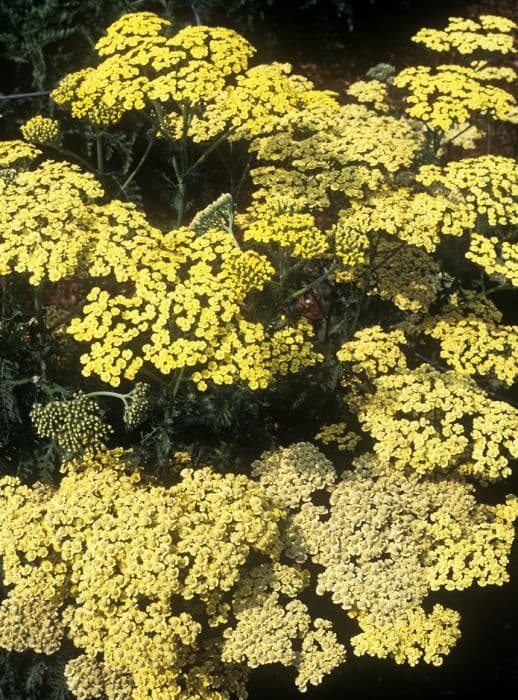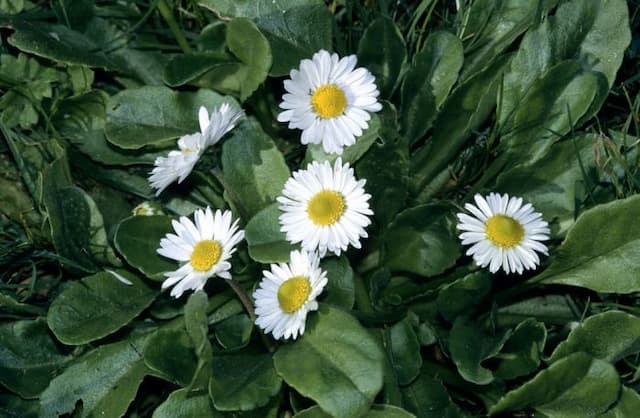Noble Yarrow Achillea nobilis subsp. neilreichii

ABOUT
The plant in question, commonly known as Noble Yarrow, features a distinct appearance with a number of characteristic traits. Its leaves are typically green, with a feathery or fern-like texture, which adds a delicate touch to the overall structure of the plant. These leaves may be arranged in a spiral formation along the stem, providing a lush, full-bodied look. The Noble Yarrow blooms are particularly noteworthy, usually sprouting from a cluster of flower heads that come together in an array or cluster. Each flower head encompasses numerous tiny, daisy-like flowers that may vary in color, often presenting shades that range between white, yellow, and pink. These blooms are not only visually appealing but they are also known to attract a variety of pollinators like bees and butterflies, which adds to the plant's charm. The stems of the Noble Yarrow are sturdy and upright, allowing the plant to maintain a robust presence in a garden setting. They support both the intricate foliage and the conspicuous blooms, creating a harmonious balance that contributes to its ornamental value. It is this combination of feathery leaves and vibrant flower clusters that distinguishes the Noble Yarrow, making it a well-regarded choice for gardeners seeking to add a touch of elegance and attraction to their garden spaces.
About this plant
 Names
NamesFamily
Asteraceae
Synonyms
Noble Yarrow
Common names
Achillea neilreichii, Achillea nobilis var. neilreichii.
 Toxicity
ToxicityTo humans
The plant known as Noble Yarrow (Achillea nobilis subsp. neilreichii) is generally not considered to be highly toxic to humans. However, like many plants, it could potentially cause allergic reactions or skin irritation upon contact for some individuals. If ingested, Noble Yarrow may cause mild gastrointestinal upset, including symptoms such as nausea, diarrhea, and vomiting. While not typically life-threatening, consuming parts of the plant, particularly in large amounts, may have adverse effects, and medical advice should be sought if symptoms arise.
To pets
Noble Yarrow (Achillea nobilis subsp. neilreichii) is not widely recognized as a significant toxin to pets. Nevertheless, it's always possible for pets to exhibit sensitivity or an allergic reaction to plants. Ingesting Noble Yarrow might lead to mild gastrointestinal distress in pets, showing as vomiting or diarrhea. As with any non-food plant ingestion, it is wise to monitor your pet for any signs of illness and to consult with a veterinarian if any worrisome symptoms occur.
 Characteristics
CharacteristicsLife cycle
Perennials
Foliage type
Deciduous
Color of leaves
Green
Flower color
Yellow
Height
1-2 feet (30-60 cm)
Spread
1-2 feet (30-60 cm)
Plant type
Herb
Hardiness zones
5
Native area
Europe
Benefits
 General Benefits
General Benefits- Attractive to Beneficial Insects: Achillea nobilis subsp. neilreichii attracts pollinators like bees and butterflies, improving pollination in gardens.
- Drought Tolerance: This plant is highly tolerant of dry conditions once established, making it an excellent choice for xeriscaping or low-water landscapes.
- Erosion Control: The plant's dense growth and extensive root system can help stabilize the soil and control erosion.
- Low Maintenance: It requires minimal care, making it ideal for gardeners looking for low-effort landscaping options.
- Aesthetic Appeal: With its attractive foliage and flowers, it can add visual interest to a garden throughout the growing season.
- Edible Parts: Certain parts of the plant may be edible and used in culinary applications, although they should be consumed with caution and proper identification.
- Companion Planting: It may be beneficial for companion planting, working well with other plants to create a diverse and healthy ecosystem.
- Cultural Significance: It may hold cultural or historical significance in certain regions, which can add an element of heritage to a garden.
- Wildlife Habitat: Provides habitat and food for various insects and animals, contributing to local biodiversity.
- Soil Improvement: Can help in the improvement of soil health by adding organic matter when its foliage decomposes.
 Medical Properties
Medical Properties- Anti-inflammatory: The plant has been traditionally used to reduce inflammation.
- Antispasmodic: It may help to alleviate spasms of the muscles.
- Astringent: Can be used to tighten tissues and staunch bleeding.
- Carminative: Known to help relieve flatulence.
- Diaphoretic: May induce sweating and help lower fevers.
- Emmenagogue: Has been used to stimulate menstrual flow.
- Hepatoprotective: Some components are thought to offer liver protection.
- Vulnerary: Used to assist in wound healing.
- Choleretic: Can stimulate the production of bile, aiding digestion.
 Air-purifying Qualities
Air-purifying QualitiesThis plant is not specifically known for air purifying qualities.
 Other Uses
Other Uses- Achillea nobilis subsp. neilreichii, commonly known as Noble Yarrow, can be used as a companion plant in the garden to repel certain pests due to its strong scent.
- In the dyeing industry, Noble Yarrow can provide a range of green to yellow hues on wool, depending on the mordants used.
- The plant can be used as a compost activator, promoting the decomposition process due to its high nitrogen content.
- Noble Yarrow's foliage is sometimes incorporated into bouquets and floral arrangements for its delicate feathery leaves and aesthetic appeal.
- The dried stems and flowers of Noble Yarrow can serve as components in potpourri, contributing a lasting aroma to the mix.
- This plant might be used as a natural lawn alternative in some settings, as it can endure mowing and is resistant to drought.
- Noble Yarrow can also be used in the restoration of disturbed soils as its roots help in soil stabilization and erosion control.
- In some cultures, the flowers of Noble Yarrow are used in traditional handicrafts, such as decorative wreaths and ornaments.
- The plant can serve as a natural mulch, providing essential nutrients to the soil as it decomposes and suppressing weed growth.
- Some gardeners use the distinctive foliage of Noble Yarrow as an edging plant to define the borders of garden beds and pathways.
Interesting Facts
 Feng Shui
Feng ShuiThe Noble Yarrow is not used in Feng Shui practice.
 Zodiac Sign Compitability
Zodiac Sign CompitabilityThe Noble Yarrow is not used in astrology practice.
 Plant Symbolism
Plant Symbolism- Healing: Achillea is named after Achilles, the Greek hero of the Trojan War, who was said to have used the plant to treat wounds of his soldiers, reflecting the plant's historical use in herbal medicine for its healing properties.
- Courage and Protection: In mythology, Achilles' use of the plant symbolizes not only healing but also the courage in battle and the protective qualities against physical harm, a trait potentially emulated by the plant's resilience.
- Love and Attraction: The plant's beauty and aromatic qualities have been associated with love and attracting affection, as it was historically used in love charms and spells.
- Divination: In some folk traditions, Achillea nobilis was believed to have powers of divination, specifically for answering questions about the future or revealing one's romantic destiny.
- Perseverance: Its hardy nature and ability to thrive in various conditions signify perseverance and adaptability in overcoming obstacles.
 Water
WaterFor Noble Yarrow (Achillea nobilis subsp. neilreichii), watering should be done carefully to maintain moderate soil moisture without causing waterlogged conditions. During the active growing season, water the plant deeply once a week, ensuring that about 1 to 1.5 gallons of water per square yard is applied. Reduce watering frequency in the fall and winter when plant growth slows down. If the weather is particularly hot or dry, monitor the soil and water additionally if the top inch becomes dry. Always water at the base of the plant to avoid wetting the foliage which can promote disease.
 Light
LightNoble Yarrow thrives best in full sun conditions, which means it requires at least 6 hours of direct sunlight per day. The ideal spot for planting Noble Yarrow would be in an area where it can enjoy uninterrupted sunlight throughout the day. While the plant can tolerate some light shade, too much shade can result in weakened growth and fewer blooms.
 Temperature
TemperatureNoble Yarrow is hardy and can tolerate a wide range of temperatures but performs best in conditions between 65 and 75 degrees Fahrenheit. It can survive short periods of cold down to around 5 degrees Fahrenheit, but prolonged exposure to temperatures below 10 degrees Fahrenheit may harm the plant. During hot summers, temperatures above 90 degrees Fahrenheit are typically well-tolerated, especially if the plant is well-watered.
 Pruning
PruningPrune Noble Yarrow to maintain its shape, remove spent flowers, and encourage further blooming. Deadheading, or cutting off the faded flowers, should be done regularly throughout the blooming season. At the end of the flowering season, usually in late fall, cut back the foliage to a few inches above the ground to help maintain the plant's vigor. Pruning is also an opportunity to remove any damaged or diseased stems.
 Cleaning
CleaningAs Needed
 Soil
SoilNoble yarrow thrives in well-draining soil with a pH range between 6.0 and 7.5. A mix of garden soil, compost, and coarse sand or perlite will create an ideal environment. Ensure the soil is fertile and not overly rich to promote healthy growth.
 Repotting
RepottingNoble yarrow does not require frequent repotting and should be replanted every 2-3 years to replenish the soil. Always use a slightly larger pot to accommodate root growth.
 Humidity & Misting
Humidity & MistingNoble yarrow prefers a drier environment and will thrive in average to low humidity conditions typically found in temperate climates. This plant does not require high humidity levels.
 Suitable locations
Suitable locationsIndoor
Ensure full sun, well-draining soil, and occasional watering for noble yarrow.
Outdoor
Plant noble yarrow in full sun, in well-draining soil, and water moderately.
Hardiness zone
3-9 USDA
 Life cycle
Life cycleAchillea nobilis subsp. neilreichii, commonly known as Noble Yarrow, begins its life cycle when its seeds germinate, typically in early spring, given adequate moisture and light conditions. The seedlings establish a rosette of leaves at the soil surface as they enter the vegetative stage, a period of growth and development where they accumulate resources. As the plant matures, it develops a sturdy stem and foliage, and eventually, it enters the flowering stage, usually in late spring or early summer, where it produces clusters of small, white or cream-colored flowers that attract pollinators. After pollination, these flowers give way to seeds during the reproductive stage, which, when mature, are dispersed by wind, water, or other means. The Noble Yarrow is a perennial herb, therefore it can survive through multiple seasons with the above-ground portions dying back in the winter and regrowing the following spring from the rootstock. Some plants may also reproduce asexually through rhizomes, contributing to the spread and persistence of the species in its habitat.
 Propogation
PropogationPropogation time
Spring-early summer
Propogation: Achillea nobilis subsp. neilreichii, commonly known as Noble Yarrow, can be propagated most popularly by seed. The best time to sow the seeds is in spring or early summer. The propagation process by seeds involves scattering them on the surface of a well-draining seed starting mix and lightly pressing them into the soil, as they require light to germinate. Noble Yarrow seeds typically germinate within two to three weeks when kept at a temperature around 65 to 75 degrees Fahrenheit (18 to 24 degrees Celsius). Once the seedlings have grown large enough to handle and a stable outdoor temperature is established, they can be transplanted to their desired location in the garden.









